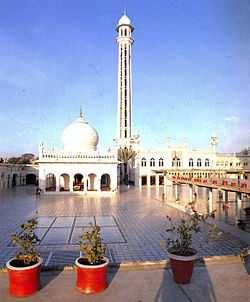Meher Ali Shah
| Pir Meher Ali Shah | |
|---|---|
 | |
| Religion | Islam, specifically the Chishti Sufi order |
| Personal | |
| Born |
14 April 1859 Golra Sharif |
| Died |
May 1937 (aged 78) Golra Sharif |
| Senior posting | |
| Based in | Golra Sharif |
| Title | Pir |
| Predecessor | Hazrat Khawaja Shams-ud-din Sialvi |
| Successor | Pir Syed Ghulam Mohiyyud Din Gillani |
Meher Ali Shah (Urdu: پیر مﮩرعلى شاه ) was a Sufi scholar, known to his followers as a saint, who was born on 14 April 1859 (1 Ramadan, 1275 A.H.) in Golra Sharif,[1] which is located midway between Rawalpindi and Islamabad, in present-day Pakistan. He is known as a Sufi saint, a Hanafi scholar upholding the position of Abdul-Haqq Dehlavi, and a leader of the anti-Ahmadiyya movement. He wrote several books, most notably Saif e Chishtiyai, (The Sword of the Chishtis), a polemical work regarding the unorthodoxy and the heresy of the Ahmadiyya movement of Mirza Ghulam Ahmad.
Works
- Tahqiq-ul-Haq Fi Kalima-tul-Haq (The Truth about Kalima-tul-Haq)
- Shamsul Hidayah
- Saif-e-Chishtiya
- I’la Kalimatillah Fi Bayan-e-Wa Ma Uhilla Bihi Legharillah
- AlFatuhat-us-Samadiyyah (Divine Bounties)
- Tasfiah Mabain Sunni Wa Shi’ah
- Fatawa-e-Mehria
- Mulfuzaat-e-Mehria (Sayings of Meher Ali Shah)
Sufi of the Chishti Order
Shah was a disciple and Khalifa of Shams-ud-din in the Silsila-e-Chishtia Nizamiyah.[2] His biography, Meher-e-Muneer, records that he was also made a khalifa by Haji Imdadullah Muhaajir Makki, when he visited the latter in Mecca. Makki advised him to return to India, where a great storm was about to rise against Islam, which Shah must crush. Makki is believed by some to have been predicting the rise of the Ahmadiyya Muslim Community.


Supporter of Wahdat-ul-Wujood (The Unity of Existence)
Shah was a supporter of Ibn Arabi's ideology of Wahdat-ul-Wujood but he made a distinction between the creation and the creator (as did Ibn Arabi).[3] He also wrote explaining the "Unity of Being" doctrine of Ibn Arabi.
Like his comrade Qazi Mian Muhammad Amjad, he was an authority on Ibn Arabi and his 37-volume masterpiece The Meccan Illuminations (Al-Futūḥāt al-Makkiyya).
In 1933, Shah was absorbed in his meditation and mystic trances. That year the philosopher Muhammad Iqbal had to give a lecture at Cambridge University on Ibn Arabi's concept of Space and Time. He wrote a letter to Shah stating that now there was nobody in all of Hindustan whom he could consult in this matter, and requesting him to tell about Ibn Arabi's work. In this letter Iqbal stated with respect that he knew he was disturbing Shah's meditations, but as his motive was the service of Islam, therefore he dared to ask him a question. Shah however, due to his meditation and bad health, could not reply.[4]
References
- ↑ Mehr Muneer Biography of Meher Ali Shah
- ↑ www.thelightofgolrasharif.com
- ↑ Mulfuzaat -e- Mehrya by Meher Ali Shah
- ↑ "Mehr Muneer" a Biography of Meher Ali shah by Maulana Faiz Ahmed